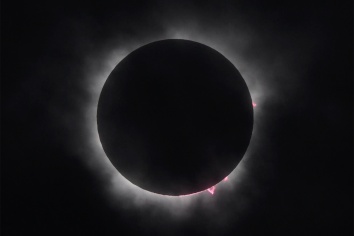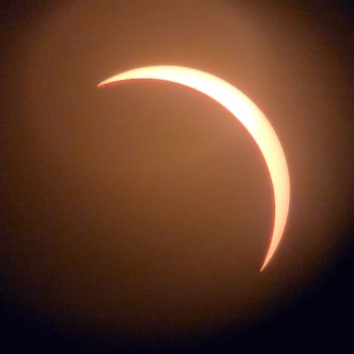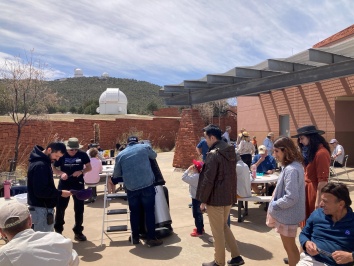
Totality, as captured in Dripping Springs, Texas. A V-shaped prominence (loop of plasma) is visible extending from the lower right portion of the Sun. Image credit: John Kormendy. Learn more about this image on the photographer's website.
7 May 2024
On Monday, April 8, a total solar eclipse swept across North America, from Mexico to Canada. Along the way, it traveled through the Lone Star State, giving Texans a second opportunity to see a solar eclipse within one year – an annular “ring of fire” eclipse was visible on October 14, 2023.
In continuation of its outreach efforts for the annular eclipse, The University of Texas at Austin’s McDonald Observatory helped the state prepare for April’s eclipse. With help from UT’s Department of Astronomy, we:
Funding from the Abell-Hanger Foundation helped support this work.
UT Austin and McDonald Observatory astronomers and staff were present throughout the path of totality to support viewing events and experience totality for themselves. In their own words, the experience was unforgettable!
Inside the path of totality, UT Austin’s Total Eclipse of the Horns campus viewing event was attended by nearly 70,000 people. The Astronomy Department and McDonald Observatory provided expertise for this event and trained volunteers to lead its solar telescope viewings.
At Austin’s Long Center for the Performing Arts, UT astronomers participated in the Simons Foundation’s “In the Path of Totality” event, which was attended by thousands and included a replica of the McDonald Observatory's Hobby-Eberly Telescope.
Outside the path of totality, McDonald Observatory hosted its own celebration for the partial eclipse. It included solar telescope viewings, educational activities, and demos. Over 100 attended. Joshua Santana, a McDonald Observatory optomechanical engineer who was at the event noted what a pleasure it was connecting with visitors on such a special day, sharing his expertise, and “seeing their excitement.” Stephen Hummel, the Observatory’s Dark Skies Initiative coordinator added, “While only a partial, it was still memorable!”
If April’s eclipse sparked (or confirmed!) an interest in astronomy, we invite you to visit McDonald Observatory in West Texas. The Observatory offers daytime programs, such as tours and solar viewings, as well as evening programs, such as Star Parties and Special Viewing Nights. To stay up to date on Observatory news and programming, consider following us on Instagram, Facebook, and X.
You can also subscribe to McDonald Observatory’s StarDate magazine, which publishes skywatching information and the latest astronomy news six times a year.
We look forward to sharing more astronomical events with you in the future!

Totality, as captured in Dripping Springs, Texas. A V-shaped prominence (loop of plasma) is visible extending from the lower right portion of the Sun. Image credit: John Kormendy. Learn more about this image on the photographer's website.

Eclipse watchers in the path of totality. Image credit: Lindsay House.

View of the partial eclipse as seen through a telescope at McDonald Observatory. Image credit: Cassie Crowe.

McDonald Observatory hosted a viewing event for the partial eclipse. It included solar telescopes, educational activities, and demos. Over 100 attended. Image credit: Stephen Hummel.